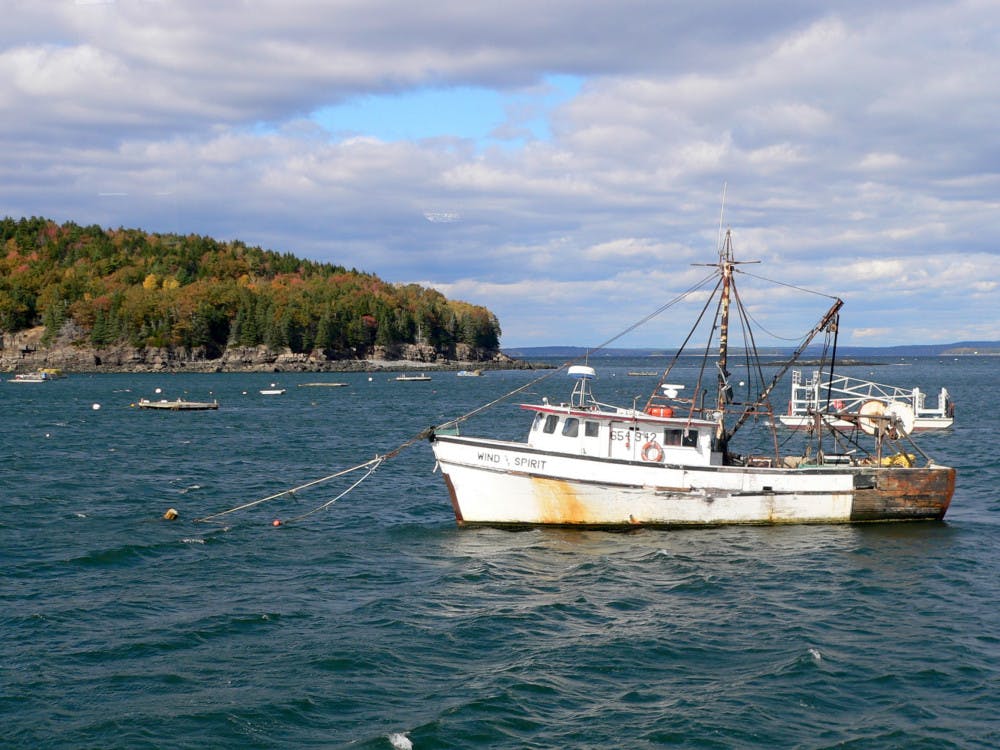When Greg Mataronas steams out of Narragansett Bay as early as 3 a.m., he is headed for grounds he knew as an eight-year-old. A native Rhode Islander, Mataronas grew up lobstering in Little Compton. After college, he returned to the ocean, unable to resist a profession rife with memories of his childhood. But as a commercial lobsterman, Mataronas’ days are far from youthful. Early morning wake-up calls, 16-hour days and occasional bouts of seasickness take their physical toll, and he has watched the lobster population around him decline over the last two decades. But more than the grueling lifestyle, there is a new force threatening Mataronas’ ability to provide for his wife and children: offshore wind energy.
Permanent steel wind turbines lining the seafloor impose new barriers to the lobster industry, which is dependent on and accustomed to an open ocean.
“We’ve had other things come through where it’s threatened to change the way we do things, but wind farms are different,” Mataronas said.
Many fisherpeople see a future where segments of their industry will ultimately disappear unless the federal government ensures their concerns are taken into account in the construction and development of wind farms. Fisherpeople’s fears include the incompatibility of certain types of fishing gear with the clustered placement of wind turbines and a lack of site-specific research regarding economic and ecological impacts of the turbines.
As companies move closer to achieving large-scale offshore wind farms, commercial fisherpeople are increasingly worried they will be left behind. Three wind energy projects, Bay State Wind, Deepwater Wind and Vineyard Wind, are leasing ocean area off the coast of Rhode Island and Massachusetts from the federal government. Vineyard Wind, the first and only project to submit a concrete plan for construction to the Bureau of Ocean Energy Management, is set to build up to 106 turbines off the coast of the two states once their plan is approved by BOEM, according to its Dec. 2017 proposal. BOEM concluded public meetings for comment on the plan Thursday at the University of Rhode Island.
One of the lawyers at the meeting, Tricia Jedele, representing the East Farm Commercial Fisheries Center of Rhode Island, told The Herald that the planned Vineyard Wind farm is “basically plopped right in the prime squid fishing grounds.”
“Our nets stretch one-fourth-mile wide,” said Stephen Bode, a fourth-generation squid fisherman. “We need at least four miles between each wind farm to be able to fish in between them. So it’s excluding us. Our fishery will be 100 percent excluded from fishing in this area.”
Meghan Lapp, a fisheries liaison for Seafreeze Limited, an R.I.-based producer and trader of sea-frozen seafood, is also frustrated with a lack of communication between fisherpeople and wind energy companies. Though BOEM requires each wind energy company to construct and implement a “fisheries communication plan,” which details how the company will engage with and hear from the fishing industry, many fisherpeople complain that talk is not translating into action.
“All of our concerns fall on deaf ears,” Lapp said. “I personally have been meeting with BOEM for three years.” Lapp added that she gave “confidential business information” from over 20 fishing vessels to BOEM to demonstrate that there was heavy fishing activity on one particular lease site, but she said BOEM issued the lease regardless.
But according to Brian Krevor, BOEM’s environmental coordinator for the Vineyard Wind project, BOEM does listen to and consider the concerns of fisherpeople. As a result of “comments and concerns” from those in the fishing industry, they reduced the original chunk of sea they were considering for lease by 60 percent, Krevor said. “And from there we got more comments and concerns, we removed another area for fishing,” he added.
In more than one specific instance, BOEM has welcomed the voices of fisherpeople, Krevor said. Since 2009, BOEM has held over 20 public meetings in the Kingston region alone to engage with the fishing industry and create “a very interactive process,” Krevor said. BOEM has also responded to concerns surrounding wind turbines’ economic and ecological impact by conducting various research studies.
Motivation to find common ground between the fisherpeople and the wind industry lies in the potential environmental and economic benefits. The clean energy and new job market created by wind energy is in line with a recent R.I. initiative: In March 2017, Gov. Gina Raimondo announced that she aimed to multiply clean energy in Rhode Island tenfold by the end of 2020. BOEM’s offer to lease areas offshore of Rhode Island and Massachusetts could reduce the states’ carbon footprint and add energy diversity, according to BOEM’s Chief of the Office of Renewable Energy Programs Jim Bennett.“We have a world class wind resource, we have a buildable environment with a shallow, sloping shelf and we have markets between Boston and New York like no other,” he said. “And all of these things combined make a really attractive future for wind energy.”
With more meetings and communication, several BOEM representatives believe the two industries have the potential to grow side by side.
“I think they can coexist, but there has to be a willingness to listen to each other and a willingness to work together,” Krevor said. “And we need to be here facilitating that.”
But some fisherpeople remain unconvinced that their industry will flourish alongside offshore wind.
“The only thing that could be done would be that the wind farms are initially sited not on commercial fishing grounds,” Lapp said. “That’s the only thing that could be done. I don’t think that the two could ever coexist.”





